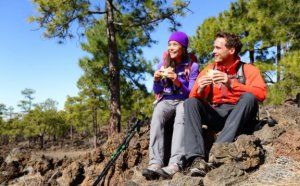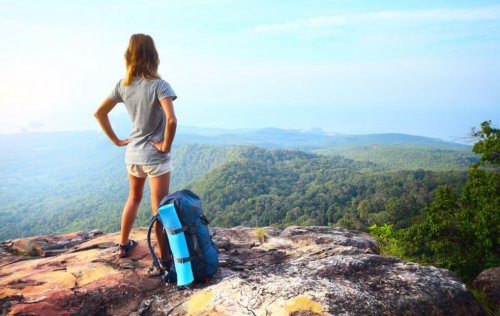The Importance of Nutrition for Mountaineers

Mountaineering is a sport that demands special training from those who practice it. The energy and hydration requirements in high environments are much more delicate than with any other sport. If you want to practice mountaineering, it’s fundamental that you follow the proper nutrition guidelines for mountaineers.
The mountain: a demanding place
Mountain conditions are very different from the plains. Low temperatures, lower atmospheric pressure, low humidity, little oxygen in the air; they all alter the physiology of those who practice mountaineering.
When performing any sport, the energy your body needs increases, especially when it comes to mountain sports. Therefore, besides specific physical training, these sports require a nutrition plan for mountaineers.
The figures say it all! A mountaineer burns between six hundred and eleven hundred calories per hour. This is almost four times more than a cyclist burns on flat terrain.

The physical and technical shape of the athlete, their weight and environmental factors, also play a role in the number of calories burned. But, the data is still valid in order to understand the consequences of inadequate nutrition. If a mountaineer doesn’t have enough nutrient storage in their body, the body will use the energy from its own fat. If there’s no fat, the muscles become the fuel.
Key nutrition for mountaineers
Training and nutrition are two sides of the same coin. Both aspects define the physical shape of the mountaineer and both are essential. You must give these aspects the same attention.
It’s not enough that a mountaineer dedicates several hours each day to training and exercise. These routines are only half of the overall physical preparation. The other half is achieved by implementing a specific nutritional plan for mountaineers.
What are the essential nutritional aspects to practice mountain sports? Below, are the guidelines that every good mountaineer must keep in mind:
Hydration
It’s fundamental to maintain your hydration. Becoming used to drinking lots of fluids throughout the day will provide the mountaineer with the amount of water they need. Before starting any activity, during and after it, water is essential.
This is an important requirement even during training. In addition, water is low in salts, so you must add rehydration salts to your bottle.
Isotonic drinks also help. They’re preparations that favor hydration and restore the electrolytes you lose when doing physical activity. We recommend that you take these drinks with you, to help you, during mountaineering.

In order to complete a trekking tour successfully, make sure you plan out the path and wear the correct clothing.
Carbohydrates
In mountain sports, caloric expenditure increases significantly. Therefore, it’s fundamental that you maintain the “carbohydrate storage” so that it’s always available in your body.
The greatest glycogen contribution for your body comes from carbohydrates. A nutritional plan for mountaineers must emphasize the intake of foods that provide the body with enough carbohydrates.
In order to optimize the storage of carbohydrates, you must eat them before, during and after any physical activity. So, if a mountaineer has a very demanding training routine, their usual diet will be rich in these nutrients.
During mountaineering
As a general rule, the daily caloric intake of mountaineers should be between 3,500 to 5,000 calories. This according to the conditions of the mountain environment.
A hypercaloric diet, rich in carbohydrates and fats and low in protein is most appropriate. Experts suggest a diet comprising of 60 percent carbohydrates, 30 percent fats, and 10 percent protein. These proportions lower the consumption of oxygen in order to transform food into energy.
This contribution of extra nutrients is necessary for athletes to avoid hypoxia. Chocolate, bread, crackers and cookies are foods that are rich in calories and weigh little.
The diversity of mountain sports determines the variation of the diet. But, with any mountain activity, the nutrition of mountaineers must be planned out carefully. Otherwise, training is pointless, since the body won’t be able to endure as much.
Mountaineering is a sport that demands special training from those who practice it. The energy and hydration requirements in high environments are much more delicate than with any other sport. If you want to practice mountaineering, it’s fundamental that you follow the proper nutrition guidelines for mountaineers.
The mountain: a demanding place
Mountain conditions are very different from the plains. Low temperatures, lower atmospheric pressure, low humidity, little oxygen in the air; they all alter the physiology of those who practice mountaineering.
When performing any sport, the energy your body needs increases, especially when it comes to mountain sports. Therefore, besides specific physical training, these sports require a nutrition plan for mountaineers.
The figures say it all! A mountaineer burns between six hundred and eleven hundred calories per hour. This is almost four times more than a cyclist burns on flat terrain.

The physical and technical shape of the athlete, their weight and environmental factors, also play a role in the number of calories burned. But, the data is still valid in order to understand the consequences of inadequate nutrition. If a mountaineer doesn’t have enough nutrient storage in their body, the body will use the energy from its own fat. If there’s no fat, the muscles become the fuel.
Key nutrition for mountaineers
Training and nutrition are two sides of the same coin. Both aspects define the physical shape of the mountaineer and both are essential. You must give these aspects the same attention.
It’s not enough that a mountaineer dedicates several hours each day to training and exercise. These routines are only half of the overall physical preparation. The other half is achieved by implementing a specific nutritional plan for mountaineers.
What are the essential nutritional aspects to practice mountain sports? Below, are the guidelines that every good mountaineer must keep in mind:
Hydration
It’s fundamental to maintain your hydration. Becoming used to drinking lots of fluids throughout the day will provide the mountaineer with the amount of water they need. Before starting any activity, during and after it, water is essential.
This is an important requirement even during training. In addition, water is low in salts, so you must add rehydration salts to your bottle.
Isotonic drinks also help. They’re preparations that favor hydration and restore the electrolytes you lose when doing physical activity. We recommend that you take these drinks with you, to help you, during mountaineering.

In order to complete a trekking tour successfully, make sure you plan out the path and wear the correct clothing.
Carbohydrates
In mountain sports, caloric expenditure increases significantly. Therefore, it’s fundamental that you maintain the “carbohydrate storage” so that it’s always available in your body.
The greatest glycogen contribution for your body comes from carbohydrates. A nutritional plan for mountaineers must emphasize the intake of foods that provide the body with enough carbohydrates.
In order to optimize the storage of carbohydrates, you must eat them before, during and after any physical activity. So, if a mountaineer has a very demanding training routine, their usual diet will be rich in these nutrients.
During mountaineering
As a general rule, the daily caloric intake of mountaineers should be between 3,500 to 5,000 calories. This according to the conditions of the mountain environment.
A hypercaloric diet, rich in carbohydrates and fats and low in protein is most appropriate. Experts suggest a diet comprising of 60 percent carbohydrates, 30 percent fats, and 10 percent protein. These proportions lower the consumption of oxygen in order to transform food into energy.
This contribution of extra nutrients is necessary for athletes to avoid hypoxia. Chocolate, bread, crackers and cookies are foods that are rich in calories and weigh little.
The diversity of mountain sports determines the variation of the diet. But, with any mountain activity, the nutrition of mountaineers must be planned out carefully. Otherwise, training is pointless, since the body won’t be able to endure as much.
All cited sources were thoroughly reviewed by our team to ensure their quality, reliability, currency, and validity. The bibliography of this article was considered reliable and of academic or scientific accuracy.
- Magyari-Saska, Z., Dombay, S., & Seer, M. (2011). Determining and Presenting Mountain Trails Quantitative Data. In 11th International Multidisciplinary Scientific GeoConference SGEM2011. https://doi.org/10.5593/SGEM2011/S09.105
- Miles, M. P., Walker, E. E., Conant, S. B., Hogan, S. P., & Kidd, J. R. (2006). Carbohydrate Influences Plasma Interleukin-6, But Not C-Reactive Protein or Creatine Kinase Following a 32-km Mountain Trail Race. International Journal of Sport Nutrition and Exercise Metabolism. https://doi.org/10.1123/ijsnem.16.1.36
This text is provided for informational purposes only and does not replace consultation with a professional. If in doubt, consult your specialist.








